S - Scarification, an old practice of marking the skin with incision designs. It has been a part of African culture for centuries.
C - Cultural significance of scarification varies among African communities.
A - Africans have also used scarification as a right of passage, status symbol, medicine and for beauty.
R - Religious beliefs also influenced whether some communities used scarification.
I - Individual achievements, skills, and spiritual beliefs are often shown in the scars.
F - From linear to excision scarification, the types of scarification used in Africa are diverse and rich.
I - It is a form of self-expression. Scarification showcases the individual's achievements, skills, and spiritual beliefs.
C - Community traditions play a significant role in Scarification in Africa. The markings show African communities' rich history, beliefs, and practices.
A - Although scarification is still practised in some communities, it has recently faced criticism—especially concerns about health risks and cultural appropriation.
T - There is a need to curb the dangers associated with scarification but, at the same time, keep the culture alive.
I - Is this even possible without losing the culture in its entirety?
O - Of utmost importance is addressing the health risks associated with scarification.
N - Next, modernising the methods and documenting the existing designs is necessary.
Types of Scarification practised in Africa.
There are six types of scarification practised in Africa.
Linear Scarification
It involves making lines or shapes on the skin by cutting or etching the skin.
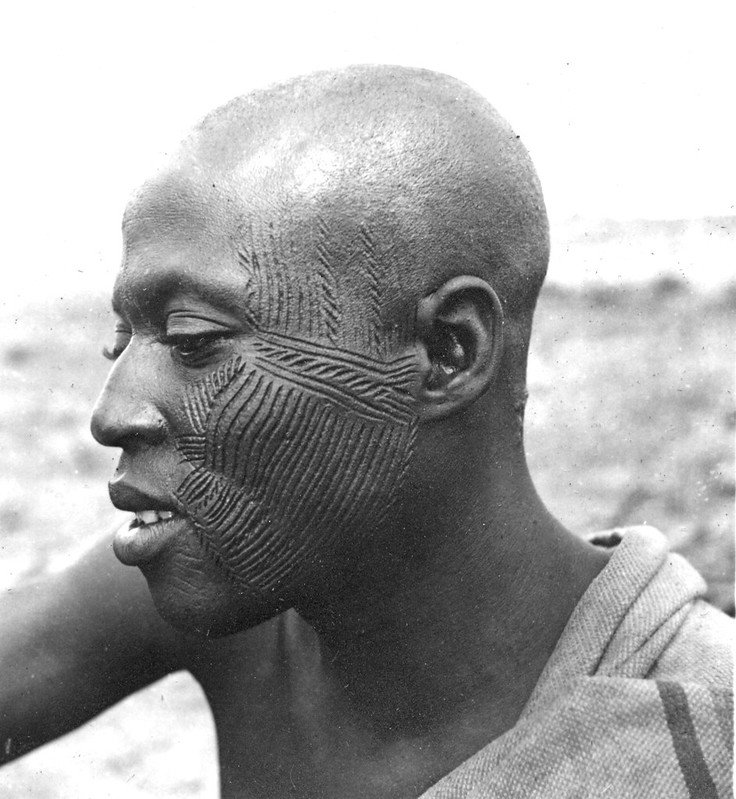
Cross-hatching Scarification
It involves making a series of intersecting lines or shapes on the skin.

Dot Scarification
It involves making small dots on the skin, either in a pattern or scattered.

Branding Scarification
It involves using heat to burn the skin, creating a raised scar.
Some communities used branding scarification as a punishment for breaking cultural rules.
Incision Scarification
It involves making deep cuts into the skin, resulting in raised scars.

Excision Scarification
Excision Scarification involves removing a piece of skin, creating a sunken scar.

Impression Scarification
One would use an object, such as a knife, to press into the skin, creating a permanent scar.

Fun Fact
The earliest recorded instances of scarification appear in Egyptian hieroglyphics.
Why was scarification done?
- To show cultural identity
- For the religious and spiritual significance
- As a rite of passage into adulthood
- For medication
- For beautification
- Symbol of status.
Religious and Spiritual significance
The Ashanti use scarification as a therapy for people who have experienced trauma and abuse. The scars symbolise the individual's ability to heal. The scars release negative energy.
They believe that scarification helps people reclaim their power and find closure.
In Bambara culture, scarification marks are drawn onto a newborn's face on the eighth day. The family member examines the baby, predicts its personality traits, and assigns a name based on observation.
The practice stems from the belief that the mythical ancestor of the Bambara (Kuma Tigi) also bore this marking.
These scars help identify members of the community. Bambara people believe the scars help newborns connect with their ancestors. The connection gives the newborn the moral and physical qualities necessary for success.

Cultural identity
African communities use different types of marks as a form of identity. The scarifications range from simple lines or dots to more elaborate designs.
For example, the Yoruba have face scars called Kolo which is circular or spiral in design. They symbolise the individual's connection to their family, community, and spirituality.
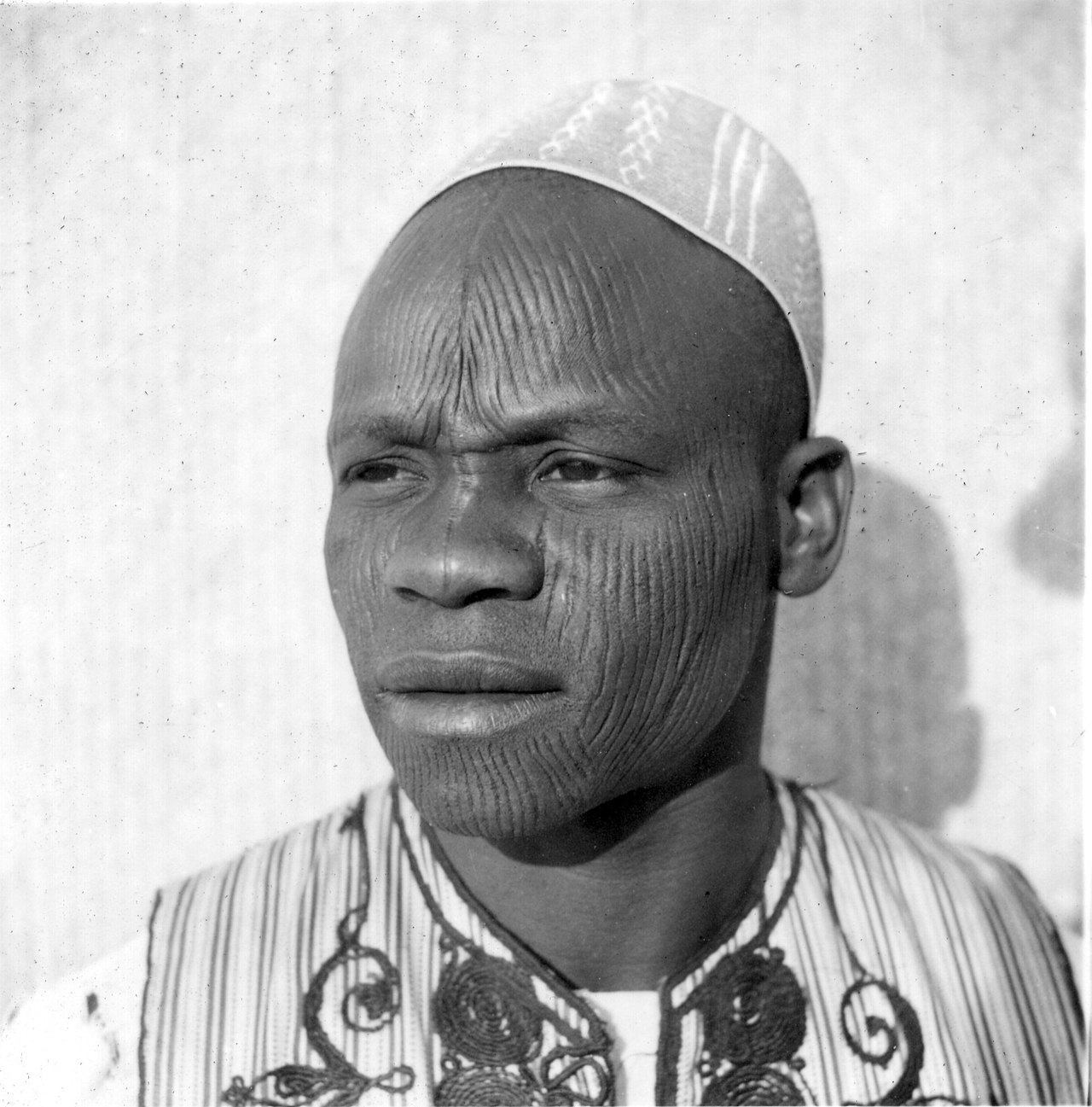
The Dinka, Nuer and other Nilotic groups in south Sudan have tribal scars on the forehead. While the Nuer have horizontal scars, those of the Dinka are fan-shaped.
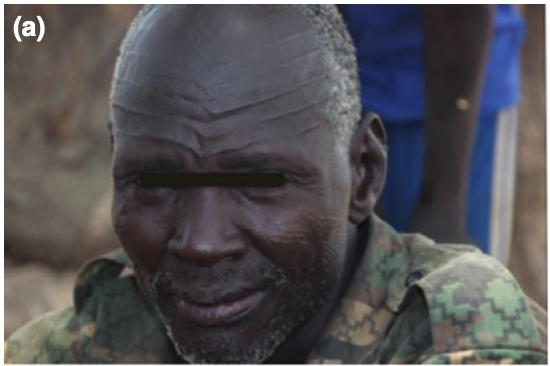
The Toposa also use impressive designs as tribal marks.
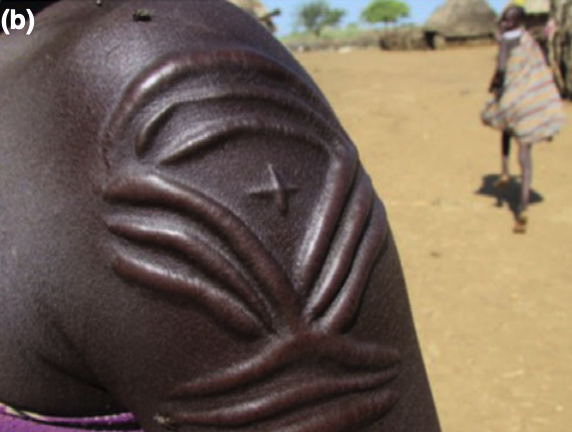
Rite of passage
Scarification is also used to mark a rite of passage in many African cultures. The mark is a permanent reminder of the journey and events experienced in life.
Among the Karo tribe, scarring on the stomach indicated a woman's fertility.
People believe that if a woman can withstand the pain of scarring, she can handle childbirth.
Scarification marks on a woman's face make her desirable as a wife in Karo culture.
The scars are believed to remain sensitive for years providing an erotic sensation for both men and women.
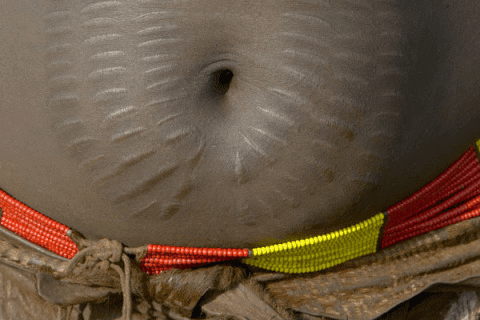
Medication
Scarification is used to find specific medical conditions and to improve psychological functionality.
The Himba use scarification to administer remedies for snake bites. They also believe it can cure fertility problems and mental illness.
For snake bites, the traditional healer makes a series of cuts on the affected area and applies a mixture of herbs to the wounds. This is believed to help draw out the poison and prevent it from spreading throughout the body.
For fertility issues, the healer makes cust on the stomach/lower abdomen and then applies a mixture of herbs.
This helps to balance hormones and restore fertility.
To treat mental illness, they would make an incision on the forehead and apply a mixture of herbs and other remedies to the wounds.
The medicine helps to release negative energy and restore balance to the mind.
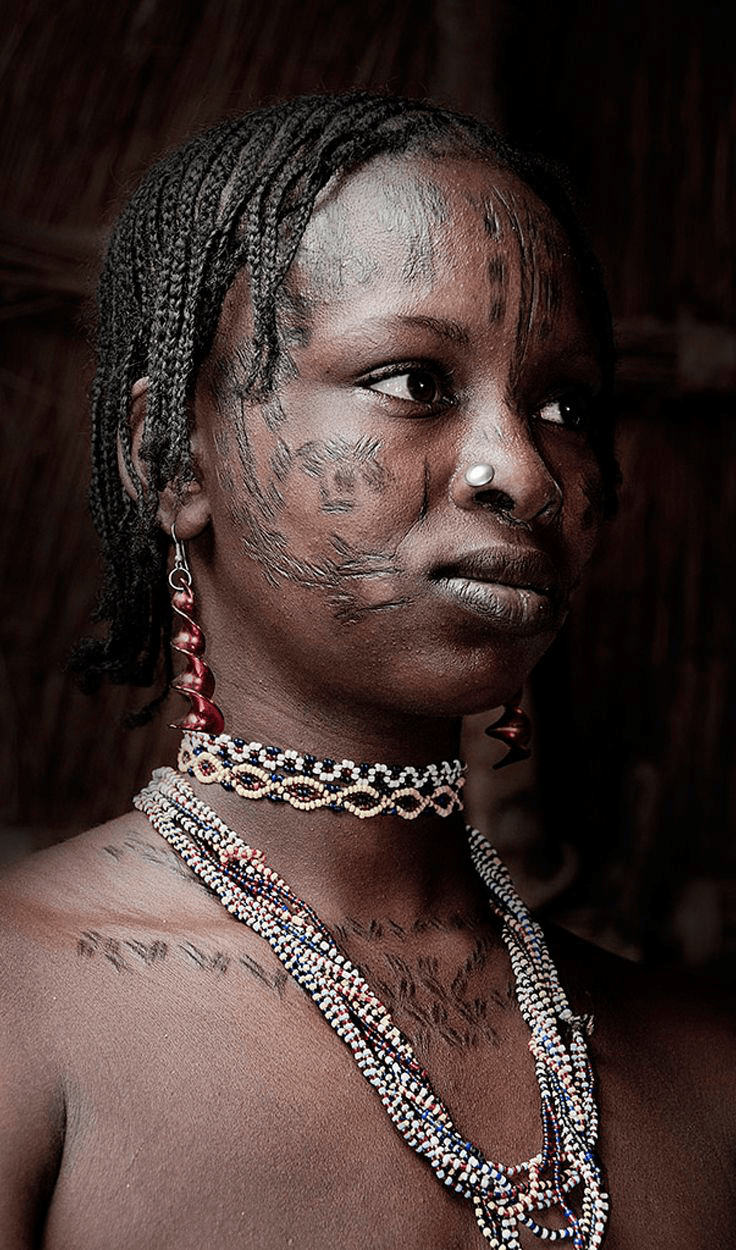
The Nuba tribe make scars above the eyes to improve eyesight and on the temple to relieve headache.
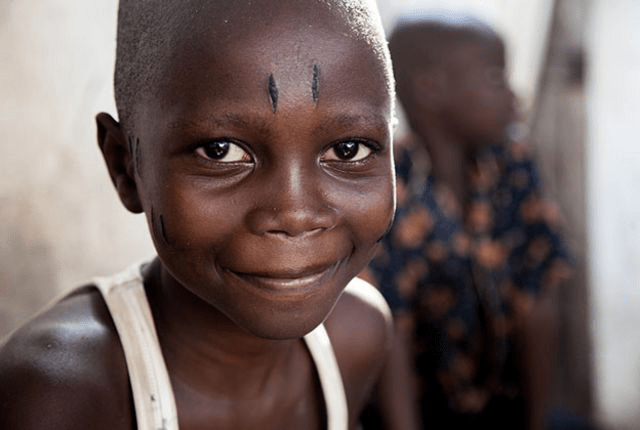
The Dagomba people use scarification to treat various illnesses such as Malaria, stomach pain and pneumonia.
They believe these illnesses stem from the blood.
A traditional healer cuts the skin and applies powdered herbs to the wound. The herbs cleanse the diseases from the bloodstream.
Beautification
Among the Surma woman, a wooden hook or edged thorn is used to upraise the part of the skin to be scarred.
The dry blood is removed, and the lesions are filled with ash and mud. The scabs are removed, and crocodile dung is rubbed in the lesions to prevent the wound from healing.
The inflammatory process favours the formation of keloids for an extended period.
The keloids are aesthetic assets which emphasise feminity and increase social prestige.
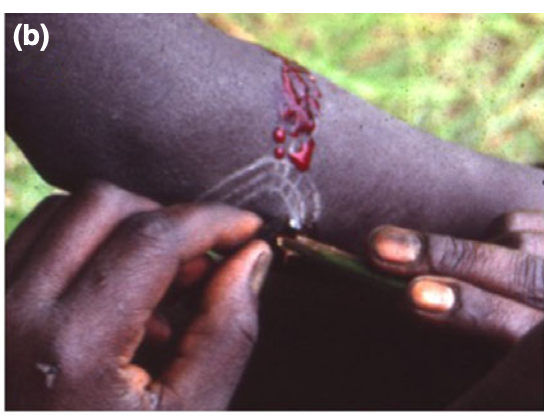
The Barabaig women of Tanzania make dotted scars around the eyes. The scars signify female perfection.
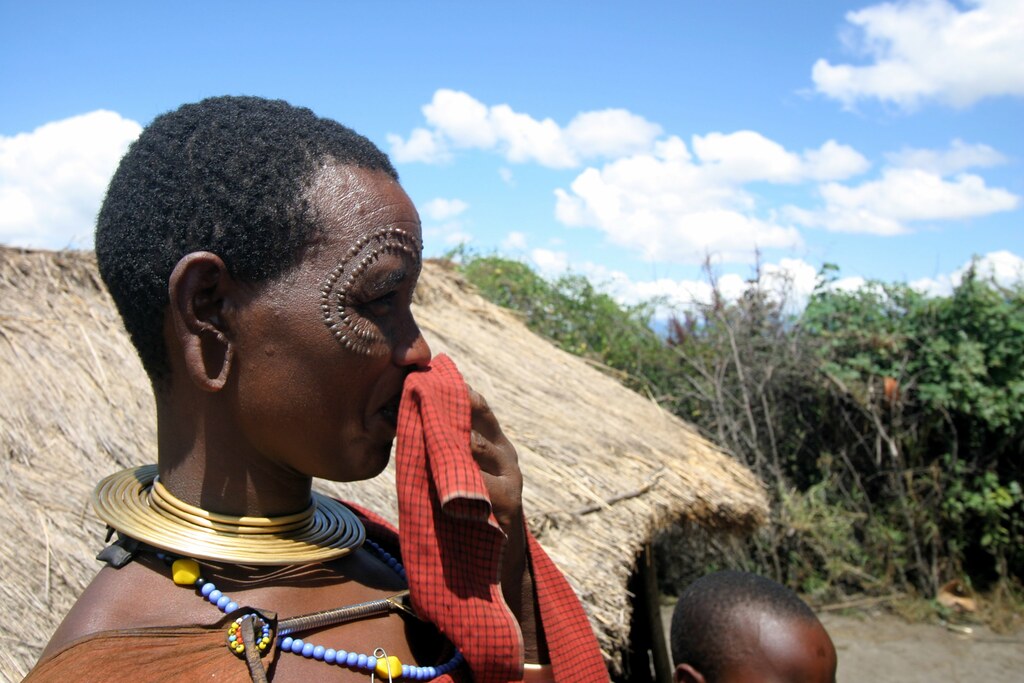
Symbol of status
Scarification also indicates someone's social status and individual achievements.
For example, some Fulani women have four-three-lane keloid chains on their faces. The keloids display their social ranking in Fulani society.
The Tonga men scar their bodies after they kill an enemy or after a successful expedition.
A keloid scar stretching from one eyebrow to the other and looking like a buffalo showed the decisiveness of a victorious hunter.
It was the same among the Maasai warrior of Kenya and Tanzania.
Decorated circular or semi-circular scars are made on the cheeks to show the bravery of the Morans.
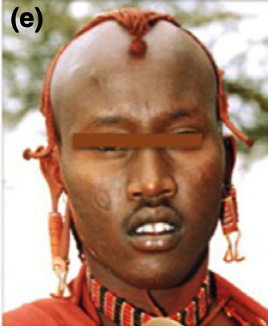
Scarification is a mark of African heritage. But, the traditional approach of doing it is a health risk.
Scarification has been associated with the rise in diseases such as Tetanus, Hepatitis virus and HIV in the communities.
We need to modernise the customs without abandoning them.
How can we achieve this?
Use modern equipment and technologies, such as those used for modernised tattoos, to administer the same art forms and symbols.
We should document and preserve the history and designs of scarifications. Achievable through recording videos, taking pictures, writing and carvings.
Join the Lughayangu Community!

